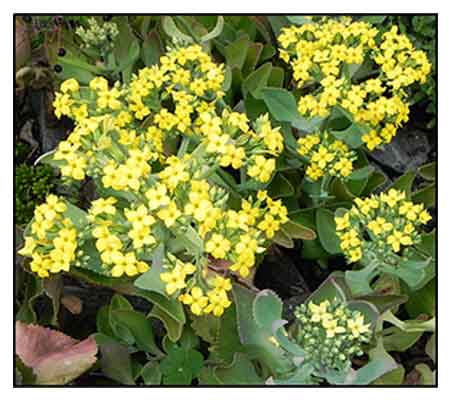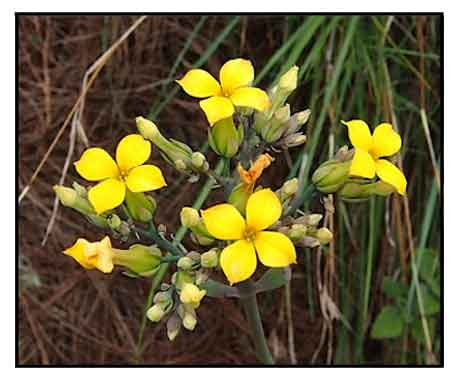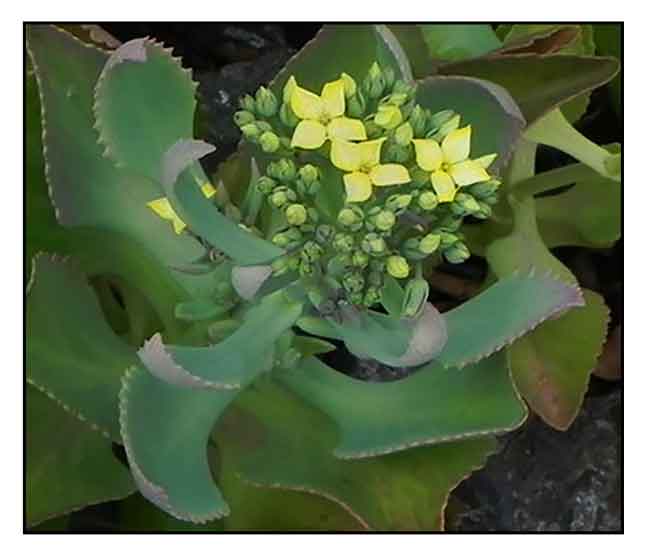 Gen info Gen info
- Kalanchoe is a genus of about 125 species of tropical, succulent plants in the stonecrop family Crassulaceae, mainly native to Madagascar and tropical Africa. A kalanchoe species was one of the first plants sent into space on a resupply to Soviet Salyut 1 space station in 1979. (3)
Botany
Kalancho integra is an herb, perennial, 40-120 cm tall, glabrous. Leaves subsessile, amplexicaul; leaf blade spatulate-oblong, 5-7 × 1.5-3.5 cm, base attenuate, margin irregularly lobed to rarely subentire, apex obtuse. Inflorescences cymose, ca. 10 cm, elongated in fruit; bracts linear. Sepals linear-ovate to narrowly triangular, apex acuminate. Corolla yellow, 1.5-2 cm; lobes acuminate at apex. Stamens inserted at corolla throat; filaments short. Nectar scales linear, ca. 3 mm. (Flora of China @ efloras.org)
Distribution
- Native to the Philippines.
- Also native to Assam, Cambodia, China, Himalaya, India, Jawa, Laos, Lesser Sunda Is., Nansei-shoto, Nepal, Sulawesi, Taiwan, Thailand, Tibet, Vietnam. (1)
- Grows primarily in subtropical biome.
 Constituents Constituents
- Study of leaves and flowers identified a glycoside, patuletin 3,7-di-O-rhamnoside, together with patuletin, quercetin, quercetin 3-O-glucoside-7-O-rhammnnoside, kaempferol, and kaempferol 3-O-rhamnoside. (11)
Properties
- Studies have shown antioxidant, antihypertensive, analgesic, anti-inflammatory, antiasthmatic, antihistaminic, mast cell stabilizing properties.
Parts used
Whole plant, leaves, sap, stems, roots.
Uses
Folkloric
- No reported folkloric medicinal use in the Philippines.
-
In Ghana, traditionally used for treatment of hypertension.
- In Bangladesh, warmed leaf juice drunk for cough. Pounded leaves are soaked overnight and the mucilaginous water is drunk on an empty stomach for bloody dysentery. Leaf juice with sugar given for gonorrhea. (12)
- In West Africa, warmed leaf sap used for treating ear ache. In Ghana, boiled leaves used for asthma, Leaf infusion drunk for palpitations and as sedative. In Nigeria, leaf infusion and decoction taken for asthma and as sedative. In Yoruba, whole plant decoctions used as anthelmintic enema; root decoction taken as tonic during pregnancy; fresh roots used as snuff or chewed to treat colds. In the Ivory Coast, leaf sap used as antiemetic and for intercostal and intestinal pain; leaves used to staunch bleeding and rubbed on feverish infants. In Taganyika, leaf sap drunk as galactagogue; root and leaf sap used as antimalarial In Zaire, leaf sap used to cicatrize wounds, cure colds and eye and ear troubles.
(13)
- In Nepal, crushed stems and leaves applied over boils to hasten bursting and healing.
(14)
 Studies Studies
• Antioxidant / Leaves: Study evaluated the antioxidant activity of methanol and aqueous leaf extract of two Kalanchoe species i.e. K. pinata and K. integra. Phytochemical analysis showed the leaf extracts were rich in total flavonoid and phenolic compounds. Total phenolic content of aqueous extract of K. integra at 340 mg/g was significantly higher than aqueous extract of K. pinnata. Aqueous extracts of both Kalancho species showed excellent antioxidant activity. The aqueous extracts were less effective. Scavenging effect of aqueous extract on DPPH radical was excellent. (6)
• Micro and Macro Element Composition / Adjuvant Treatment for Hypertension / Leaves: Study evaluated the macro- and microelemental content of K. integra and correlate them with its traditional use in the management of hypertension. Analysis revealed 12 macro and 26 micro elements in water extract and blended whole leaves of fresh K. integra leaves. The high content of calcium, potassium, and magnesium may have a positive role in the management of hypertension and arrhythmia. (7)
• Anti-Inflammatory / Analgesic / Leaves: Study evaluated the anti-inflammatory and analgesic properties of Kalancho spathulata using carrageenan induced paw edema and tail flick method respectively. Results showed that dose range of 100 and 200 mg/kg showed promising anti-inflammatory and analgesic activity in experimental animals. (8)
• Anti-Asthmatic Potential / Antihistaminic / Mast Cell Stabilizing / Leaves: Kalanchoe integra is known to possess antihistaminic and mast cell stabilizing effect.Study evaluated the anti-inflammatory effect of K. integra aqueous leaf extract on bronchial hyper-responsiveness in ovalbumin-sensitized guinea pigs. Results showed the extract exhibited significant dose-dependent reduction in histamine-induced vasodilation of cutaneal blood vessels and contractile responses of isolated trachea to histamine. Study showed the extract has potential of alleviating signs of bronchial hyperresponsiveness and skin allergies in ovalbumin-sensitized guinea pigs. (9)
• Effect on Inflammatory Wound: Study evaluated the clinical observation of K. spathulata promoting wound healing rapidly leaving no scar. In a small study of ten patients, fresh leaves were crushed, gently warmed, and applied to the wounds. Study validates the ancient concept of Ayurveda that without surgery several medicinal plants may cure diseases very well. (9)
• Poisoning / Antidotal Treatment / Experimental Poisoning: In India, study reports on experimental acute poisoning in sheep. The crude powder and decoction of whole plant were lethal to sheep. Symptoms were suggestive of cyanide poisoning and of cholinergic nature. Death was due to respiratory failure. The most effective treatment was the universal antidote: 10 g activated charcoal, 5 g light magnesium oxide, 5 g kaolin, 5 g tannin acid and water to 250cc, exerting its effect by reducing absorption of the extract and precipitation of the alkaloid in the leaf. (10)
Availability
Wild-crafted.
|

![]()



 Gen info
Gen info Constituents
Constituents Studies
Studies 